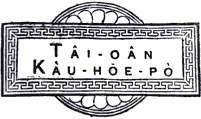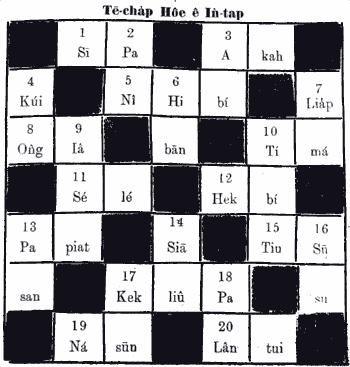
At the display for the Taiwan Church Press at the Taipei International Book Exhibition I came across a number of interesting works. The press has issued a 70-volume set of the collected newsletters of the Presbyterian Church of Taiwan. (University and research libraries, take note! So far no sets — NT$150,000 (US$4,600) each — have been sold to America or Europe.) The Presbyterian Church has long been an advocate of the rights of the people of Taiwan to speak Taiwanese without oppression, write in Taiwanese (including in romanization), and enjoy other political and human rights.
The newsletter, which dates back well into the nineteenth century, was written in romanized Taiwanese until 1969, when the KMT forced a change to Mandarin in Chinese characters. While flipping through a volume of the newsletters from the 1920s, I was startled to see that crossword puzzles in Taiwanese were a regular feature. (Click the thumbnail for a larger image.)
It’s one thing to have read of the novels, poems, religious material, and technical manuals written in Taiwanese, it’s another to see something so human and familiar leap out from the page. This really helped bring home for me how much has been lost, especially in terms of opportunities, because of the suppression of romanized Taiwanese, first by the Japanese and then by the KMT.
Interestingly, if you look at the answers below, you’ll see that each of the boxes is meant to be filled in with not an individual letter but with syllabic units.

I’ve tried my hand at creating some crosswords in Mandarin using Hanyu Pinyin, but in individual-letter, not syllabic style. This is a little tricky. In English, all letters of the alphabet can appear at the beginning, in the middle, or at the end of a word. That’s not so in Mandarin as written in Pinyin. The letters i and u, for example, never come at the beginning of a word. And no word ends with anything other than a, e, i, o, u, g, n, or r. (I’ll finish some of those crosswords one of these days, Gus!)
It would be easier to make a crossword puzzle using bastardized Wade-Giles because that has fewer letters but also more finals. But of course not as many people would be interested in solving it, me included.
For even more on the issue of the romanization of Taiwanese, see the Taiwan section of De-Sinification.


I would be interested to see your pinyin crossword puzzle. Are there word puzzles similar to crosswords that use Chinese characters?
I’ll send you a copy once I get the crosswords into electronic form, which might take some time, given that I’m not sure where I put my notes. (I tend to write things on scraps of paper, which I then misplace. This habit of mine drives my wife crazy.)
I don’t know about the situation with Chinese-character word puzzles. Maybe some readers can help out here.
Interesting. While I’ve flipped through reprinted pages of Taiwan Church News, this is the first time I am aware of them carrying crossword puzzles. The first time I saw a Taiwanese (romanized) crossword puzzle was in a campus newsletter. I guess that wasn’t so original after all.
A few more sample pages from the TCN (mixed in with non-TCN stuff).
Thanks for the additional images, a-giâu. Those are great.
Unfortunately, the press had only two of the seventy volumes of Taiwan Church News, so I couldn’t check to see when the crosswords began or ended. But they were all the way through the 1926-27 volume that I saw. The answers would be in the following issue.
Now that I know these reprints exist, I need to find some time to look through more examples at the National Central Library. Or perhaps Academia Sinica will have a set. I’m also curious to see the 1969 issue when the switch to Chinese characters was imposed.
Were the units in the campus crossword you saw syllables or letters?
It’s been a while since I’ve set my eyes on the campus newsletters (and I don’t have my copies with me right now), but IIRC those used letters rather than syllables. circa 1994.
I’d love to have the entire Taiwan Church News set digitalized in a searchable form. Just think about that! Just to cite one clear benefit: I’ve already learned that “crosswords” were known as “si?p-j? gú” (variant si?p-j? gí). This is evidently a fairly literal translation of “cross” (si?p-j?) and “word” (gú). None of the several large Taiwanese/Min Nan dictionaries I checked against lists this term, so presumably regular readers of the TCN were quite familiar with this neologism but that it failed to circulate widely in the larger population.